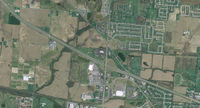Key:access_control
 |
| Description |
|---|
| The degree of access control (access to adjacent properties) along a highway. |
| Group: highways |
| Used on these elements |
| Requires |
|
| Useful combination |
| See also |
| Status: in use |
| Tools for this tag |
|
This key indicates a highway's level of access control or access management: how much a highway has been intentionally cut off from access to adjacent properties (abutters=*) and the surrounding street network. Common methods of implementing access control are building highway links similar to motorways, or building frontage roads or shared driveways that collect traffic from individual properties. Some minor cross streets may turn into dead ends ending in highway=turning_circle.
Access control is about where traffic may enter and exit the highway. Do not confuse this key with access=* and other access keys, which indicate whether traffic may access and use the highway at all.
Only use this key for intentional access control, not just because a road travels through an undeveloped area or terrain that does not have space for abutters. In some regions, this is not only a physical limitation but also a legal restriction prohibiting abutters from accessing a highway that they would otherwise have a legal right to access from their property.
Access control is very frequently implied by highway classifications. For example, an expressway (expressway=yes) can alternate between partial and full access control. Explicitly tagged access control can be useful to call out exceptions, as well as in regions where highway classification conventions are ambiguous or in flux.
Values
| Value | Comment | Example |
|---|---|---|
access_control=full
|
A fully controlled-access highway with highway links. No at-grade intersections nor direct property access. Implied by highway=motorway.
|

|
access_control=partial
|
A limited-access road, for example with frontage roads and right-in/right-out intersections. The frequency of at-grade intersections or direct property access is limited. Often correlates with expressway=yes. Maybe implied by motorroad=yes.
|

|
access_control=no
|
A road with no or very little access control features. | 
|
History
This key was first applied in 2011 along a variety of roads in the U.S. state of Kentucky.
Regional considerations
Poland
In Poland, road accessibility is defined as a property defining the frequency of intersections and interchanges, and the scope of access from abutting properties[1]. An owner of an abutting property needs to request a permission to build an access road[2] (which is likely to be rejected if the road is a limited-access road).
Autostrada and droga ekspresowa are limited-access roads[3] with mandatory full access control[4] (access_control=full). Roads of other classes can be limited-access roads too[3] (e.g. newly built GP class roads must have at least partial access control[5]), but this is not signposted.
United States
In the United States, common law gives the owner of a property a right of access to any abutting public road.[6] Access control curtails this right, and some regions post signs that explicitly say so. However, this is not a hard requirement for access_control=*, and mappers can almost always determine access control without looking for a sign on a fence.
References
- ↑ art. 4 pkt 24 Ustawy z dnia 21 marca 1985 r. o drogach publicznych
- ↑ art. 29 Ustawy z dnia 21 marca 1985 r. o drogach publicznych
- ↑ 3.0 3.1 art. 3 Ustawy z dnia 21 marca 1985 r. o drogach publicznych
- ↑ § 57 ust. 1 Rozporządzenia Ministra Infrastruktury z dnia 24 czerwca 2022 r. w sprawie przepisów techniczno-budowlanych dotyczących dróg publicznych
- ↑ § 55 ust. 1 pkt 1 Rozporządzenia Ministra Infrastruktury z dnia 24 czerwca 2022 r. w sprawie przepisów techniczno-budowlanych dotyczących dróg publicznych
- ↑ Erbe, Norman A. (1959). “A Review and Some New Thinking on Control of Highway Access”. 1959 Annual Meeting of the Highway Research Board. Washington, D.C.: Highway Research Board. Reprinted in “Land Acquisition 1959”. 38th Annual Meeting. Washington, D.C.: Highway Research Board. January 5–9, 1959. pp. 49–78.



